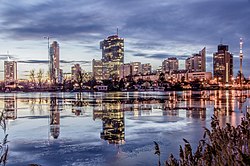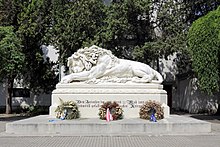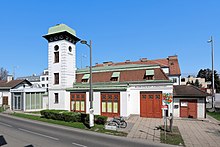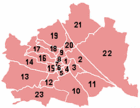Donaustadt
Donaustadt
Donaustod (Bavarian) | |
|---|---|
22nd District of Vienna | |
 | |
|
ÖVP 4, NEOS 2 | |
| Area | |
| • Total | 102.30 km2 (39.50 sq mi) |
| Population (2023-01-01)[1] | |
| • Total | 212,658 |
| • Density | 2,100/km2 (5,400/sq mi) |
| Postal code | 1220 |
| Address of District Office | Schrödingerplatz 1 1220 Wien |
| Website | www |


Donaustadt (German pronunciation: [ˈdoːnaʊˌʃtat] ⓘ; Viennese: Donaustod; "Danube City") is the 22nd district of Vienna, Austria (German: 22. Bezirk, Donaustadt). Donaustadt is the eastern district of Vienna.[2][3]
Geography
The Donaustadt district is situated in the northeast part of Vienna and is the largest of the districts by area, occupying about one-quarter of the Vienna city area, 102.24 square kilometres (39.48 sq mi). It borders the 2nd District (
The district has a large part to the west of the
By
The former Danube flood plain is now controlled in the 4 branches, or fingers, of the river, as they separate and then rejoin, all within Vienna, along the southwest edge of Donaustadt. The 4 branches are (from west to east): the
District parts
The district is made up of eight territories (former villages), whose individual coats of arms make up the coat of arms for the whole district. In the current scheme, the district is divided into those official sub-sections (German: Bezirksteile).
The eight district parts are:
In addition to these eight territories, Donaustadt also contains a ninth area,
Geology
The area of the Donaustadt District was primarily shaped by the river Danube, which, over time, formed
Land use
The developed area of Donaustadt covers 25.0% (Vienna citywide: 33.32%) of the district area, but this is the second-lowest value of a municipality in Vienna. The developed area itself is distributed as 57.4% to 28.4% as residential versus other. Donaustadt thus has a very high proportion of residences. The proportion of land to the cultural, religious, sporting or public sector are dedicated, coincides with 6.0% share. Greenspaces in Donaustadt took a total share of 58.4%. Nearly 51.9% of that green space is accounted for by agricultural land, a value only Favoriten and Floridsdorf exceeded. The bulk of the remaining green areas account for 25.71% as forests (in Lobau) or 13.45% in meadows. With a share of 8.60% of the district area, surface waters take a very high priority in use. Here the waters of the Danube and its Bayou are crucial. The proportion of trafficked area at the district is 8.02%, with the second-lowest value in Vienna. [5]
| Builtspace | Greenspace | Water | Transport areas | |||||||
| 2,556.29 | 5,968.42 | 879.17 | 819.98 | |||||||
|---|---|---|---|---|---|---|---|---|---|---|
| Residences | Oper- ations |
Public Facilities | Farms | Parks | Forests | Meadows | Small gardens | Rec. areas | ||
| 1,466.46 | 724.69 | 153.36 | 3095.7 | 100.24 | 1,534.2 | 256.41 | 802.61 | 179.2 | ||


History
The former villages of
The relatively young district (compared to the others, at least) was formed by a resolution of the Vienna Landtag on June 29, 1946. The resolution was supposed to restore the borders between Vienna and Lower Austria. However, due to the Allied occupation of Austria following the Second World War, the resolution could not immediately take effect. In 1954, the Soviet occupying authorities accepted the re-districting proposal, and the resolution took effect on July 2, 1954.
Population
|
Population Growth
Data from Statistik Austria [3]  |
Population development
The district area, of Donaustadt, had the largest population growth of all districts in Vienna. Due to the large size of today's district area and the history of horticultural or agricultural, large areas for a progressive urbanization are available. The protection of the forested Lobau section, a large share of the district land area, has limited the level of urbanization at the same time. Even before incorporation, the autonomous communities still had very high growth rates. Between 1869 and the year 1910, the population had already increased 8-fold. Up to 1939 the strong growth had continued, doubling again. After a stagnation in the 1940s and 1950s, high growth recommenced in the 1960s, which until now, is among the highest of all municipal districts. Donaustadt reached a high growth rate, in 2006, with a population of 148,980 people, making it the district with the second largest population. Nevertheless, the district is still relatively sparsely populated. With 1,420 inhabitants per square kilometer (2005), only the district Hietzing was more sparsely populated.
Population structure
In Donaustadt, the population in 2005 was younger on average than in Vienna as a whole. 18.0% of the district's population were children under 15 years, the highest value in Vienna (citywide 14.6%). The proportion of the population from 15 to 59 years at 62.9% was similar to the citywide average (63.4%), while the proportion of people aged 60 years or more was among the lowest of the Vienna districts at 19.1% (Vienna: 22.0%). The gender distribution in the district area in 2001 was 47.8% men and 52.2% women, the number of married people stood at 43.9% compared to 41.2%, above the average of Vienna.[6][7]
Origin and language
The proportion of foreign district residents in 2005 was 9.7% (Vienna citywide: 18.7%). This was the second lowest value of a district of Vienna. As in the entire state, the proportion of foreigners, however, a growth in the 2001 figure, was at 7.4%. The highest proportion of foreigners in 2005 represented approximately 1.6% share of the district population as nationals from Serbia and Montenegro. Another 0.8% were Turkish, 0.8% Polish and 0.6% German citizens. In 2001, a total of 15.9% of the minority population was born in Austria. About 2.3% expressed as a language Serbian, 1.9% Turkish, and 1.1% Croatian.[6][8]
Religious denominations
Donaustadt, due to a very small proportion of foreigners, has one of the highest populations of people of
Politics
| District Directors from 1945 | |
|---|---|
| Mathias Böhm ( KPÖ ) |
1945–1946 |
| Leopold Horacek ( SPÖ ) |
1946–1959 |
| Rudolf Köppl ( SPÖ ) |
1959–1977 |
| Rudolf Huber ( SPÖ ) |
1977–1981 |
| Albert Schultz ( SPÖ ) |
1981–1993 |
| Leopold Wedel ( SPÖ ) |
1993–1997 |
SPÖ ) |
1998–2005 |
SPÖ ) |
2005–2006 |
SPÖ ) |
2006–2014 |
SPÖ ) |
2014– |
The Soviet occupation installed
Crest (coat of arms)

The seal of Donaustadt is divided into eight panels, which represent parts of the district. In the upper left part of the crest, is the emblem of the talking
Notable personalities
- Georg Raphael Donner
- Reinhard Divis
- Martin Graf
- Bill Grah
- Siegfried Joksch (1917, Süßenbrunn – 2006, Vienna)
- Helmut Lang
- Robert Mayr-Harting
- Thomas Prager
- Franz Georg Pressler, "Fatty George"
- Josef Sara
- Robert Sara
- Rudi Stohl
- David Alaba
- Yung Hurn
- Natascha Kampusch
Culture and sights


Sightseeing
- Franzosenspeicher (French Warehouse) in Essling
- UNO-City (United Nations building in Vienna) and the Austria Center Vienna
- Danube Park and the Donauturm (Danube Tower)
- Donauzentrum (Vienna's largest shopping mall)
- Donauinsel (Danube Island)
- Alte Donau and the gaggling geese
- a part of Nationalpark Donau-Auen(Danube Meadow National Park)
- Rinterzelt, a recycling center for the City of Vienna
- Blumengärten Hirschstetten flower gardens in Hirschstetten
- Schüttkasten Essling in Essling
- Badeteich Hirschstetten in Hirschstetten
Area museums
The Donaustadt District Museum is located on the Kagraner square, and it houses a permanent exhibition of the history of the district parts. The Austrian Horticulture Museum (Österreichische Gartenbaumuseum) has been in Kagran since 1977, and it houses the largest collection of native Austrian horticulture and garden care. The collection was expanded in 2001 by collecting Sädtler (Austrian Museum flowers binding). The flower gardens Hirschstetten, with an office in Essling, Kultivationsbetriebe serve primarily as the city office. In addition, the site also includes plant and animal subjects: the gardens can be visited. The special museum Aspern-Essling 1809 dedicated to the museum as well as in bulk box Essling the
Related cities
- Porta Nuova (Milan)
- Levent (Istanbul)
- Nishi-shinjuku (Tokyo)
- La Defense (Paris)
- Jersey City (New York City) Within metropolitan area
- Manhattan (New York City)
- City of London (London)
- Washington DC) Within metropolitan area
- Central, Hong Kong (Hong Kong)
- Pudong (Shanghai)
- New Belgrade (Belgrade)
- Kirchberg, Luxembourg
See also
- Aspern Airfield - Flughafen Aspern
Notes
- ^ [ Statistik Austria – Bevölkerung zu Jahresbeginn nach administrativen Gebietseinheiten (Bundesländer, NUTS-Regionen, Bezirke, Gemeinden) 2002 bis 2022 (Gebietsstand 1.1.2022) (ODS)
- ^ Statistik Austria, 2007, webpage: statistik.at-23450 "STATISTIK AUSTRIA - Bevölkerung zu Jahres-/Quartalsanfang". Archived from the original on 2008-05-30. Retrieved 2017-09-02..
- ^ Wien.gv.at webpage (see below: References).
- ^ Thomas Hofmann. "Danube Städter geology - a round thing". In: Vienna district manuals. "22. Donaustadt district". Vienna 2002, p. 15-18.
- ^ a b "Magistratsabteilung 5 (MA5): Nutzungsarten nach Bezirken"
("Usage by District"), www.wien.gv.at, PDF file:
wien.gv.at-flaeche-PDF "Archived copy" (PDF). Archived from the original (PDF) on 2009-03-05. Retrieved 2017-12-03.
{{cite web}}: CS1 maint: archived copy as title (link). - ^ a b c Statistics Austria (2001 census) [1] [2]
- ^ MA 5 resident population by age groups and districts 2005 Archived March 5, 2009, at the Wayback Machine
- ^ MA 5 resident population by nationality and districts 2001-2005 Archived 2009-06-17 at the Wayback Machine
- ^ "City of Vienna" (crest), 2008, webpage: Wien-AT-wappen Archived December 24, 2008, at the Wayback Machine.
References
- Liselotte Hansen-Schmidt: Donaustadt. Stadt am anderen Ufer ("Donaustadt. City on the other side"). Mohl, Vienna 1992.
- Edith Müllbauer: XXII. Donaustadt. Jugend & Volk, Vienna 1985 (Wiener Bezirkskulturführer).
- Helfried Seeman (Hrsg.): Donaustadt 1860 - 1960 (Kagran, Hirschstetten, Stadlau, Aspern, Eßling, Breitenlee, Süßenbrunn, Kaisermühlen, Lobau) Verlag für Photographie, Vienna 1996.
- Birgit Trinker, Michael Strand: Wiener Bezirkshandbücher. 22. Bezirk - Donaustadt ("Vienna Handbook: 22nd District - Donaustadt"). Pichler Verlag, Vienna 2001, ISBN 3-85431-231-8.
External links
- Donaustadt webpage at wien.at
- Donaustadt in Austria-Forum (in German) (at AEIOU)
- District Museum of Donaustadt

